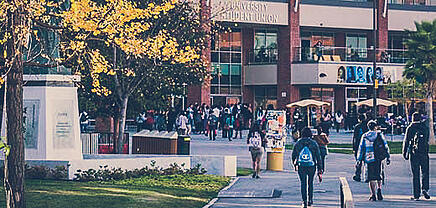If you were to step foot on any college campus today, there would be some very noticeable differences compared to just 10 years ago.
One of the most glaring differences would undoubtedly be how many students and faculty members are glued to their mobile devices.
From smart phones, to tablets and laptops, everyone on campus relies on their many (yes I said many) mobile devices; not only to study but to connect to each other and their campus environment.
Mobile has created a new kind of college experience and in doing so has put a huge strain on current campus wifi networks. How do you support thousands of students and faculty members, who are all using multiple mobile devices and applications? How do you do this securely, how do you do this in real-time, how do you do support this today while also preparing for tomorrow?
The answer is complex I’ll be honest, but I can say that it does have a common foundation and that foundation is campus-wide 802.11ac connectivity.
Real Life Applications
Not many large campuses have implemented an entire AC network. However, recently the Los Angeles campus of California State University (CSU LA) did just that, and it was no small project.
Adopting the use of an AC infrastructure for wireless networking throughout its expansive campus, they were the first of any CSU school to implement 802.11ac on this scale.
Operating at gigabit speeds, the network provides Wi-Fi capabilities sufficient to connect a campus population of over 24,000 students and 3,000 faculty/staff personnel.
It’s not surprising they choose Aruba 802.11ac solutions. According to the latest Gartner Critical Capabilities Report, Aruba Networks dominated the field in almost every category including:
- WLAN Access
- High Density WLAN Access
- Management and Administration
- On-Boarding and Policy Enforcement
Advantages of 802.11ac
Service is conducted by use of multiple access points (APs). Located throughout the campus, APs are the stations that receive and transmit data throughout the university's WLAN (wireless local area network).
In comparison to previous Wi-Fi infrastructures, 11ac features outstanding quality of service (QoS), delivering exceptional Wi-Fi experiences to all users. The latest standard's QoS is largely dependent upon:
- Ability to handle multiple messages simultaneously
- Noticeably faster speed transmitting and receiving messages/data
- Greater clarity of transmission/reception
At the same time, power consumption throughout the network is minimized, optimizing energy efficiency during operation, while lowering cost to the university. At CSU LA, APs have been situated strategically throughout the campus, providing gigabit capacity for mobile users anywhere on university property, connecting everyone wirelessly.
Reliable Performance Upgrades
AC offers considerable development from earlier versions of the 802 infrastructure. Improvements of data-rate transmissions results from 5 GHz technology producing more efficient modulation as well as additional spatial streams and wider channel-width. 11ac's considerable upgrade lends itself to efficient campus-wide implementation.
For instance, comparing 11ac to the earlier 802.11n infrastructure reveals these obvious improvements.
- The new standard currently offers data rates of 1.3 Gbps, with theoretical capacities of as much as 9.6 Gbps
- More than doubles the wireless capacities of 802.11n. For instance, at 80 MHz, channel-bonding for 11ac is significantly faster and more reliable compared to the 40 MHz level for 802.11n.
- Single-streamed smart phones can operate at 200 Mbps, compared to 72 Mbps for 11n. 11ac's channel-bonding for smart phones is 433 MHz; in contrast, 11n's is just 150 MHz.
- Double-streamed tablets run at 400 Mbps with ac, whereas 802.11n offers only 144 Mbps. 11ac's channel-bonding exceeds 11n's considerably, 860 Mbps to 300 Mbps for these two-stream applications.
- Three-streamed notebooks are at 800 Mbps for 802.11ac, while 11n generates only 216 Mbps, about 1/4 as fast. Similarly, 802.11ac's channel-bonding is registered at an optimal 1300 Mbps, while 11n's level is 450 Mbps.
802.11ac outperforms its predecessors in every mobile category, demonstrating its feasibility as a source of dependable campus-wide Wi-Fi.
Beyond CSU LA
Outside the specifics of CSU LA, 802.11ac should prove to be an indispensable tool for all universities. Its use generates a new standard for the contemporary campus environment, one responding not only to the multifaceted needs of college administration, but also to the realities of students' enhanced mobility.
Updated from previous 802 standards, AC offers delivery of wireless networks suitable for supporting the future needs of both students and the post-secondary academic community throughout higher education institutions large and small. It is particularly amenable to the escalating demands made on campus wifi from use of BOYD devices, laptops, tablets, smart phones, wearable technology, and society’s growing appetite for all things wireless.
By combining the gigabit power of Ethernet with the relative autonomy of campus wifi, 11ac's next generation performance capabilities exceed anything currently available. Its QoS and data efficiency reflect the growing incidence of on-campus mobility, enhancing its use for contemporary college life.
At SecurEdge we have helped countless numbers of colleges and universities analyze, design, deploy and support next-generation campus wireless networks. If you have any questions regarding the latest standards or would like an analysis of your current network, simply contact us here!



